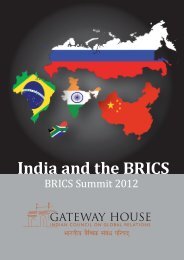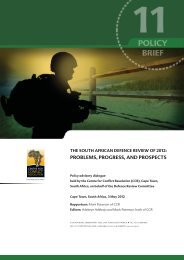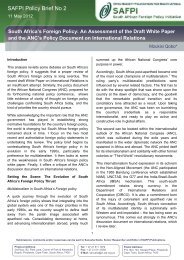Africa quarterly special on emerging powers.pdf - SAFPI
Africa quarterly special on emerging powers.pdf - SAFPI
Africa quarterly special on emerging powers.pdf - SAFPI
- No tags were found...
Create successful ePaper yourself
Turn your PDF publications into a flip-book with our unique Google optimized e-Paper software.
P A R A D I G M S H I F TDelegates at a seminar <strong>on</strong> <str<strong>on</strong>g>Africa</str<strong>on</strong>g>-EU relati<strong>on</strong>s at the <str<strong>on</strong>g>Africa</str<strong>on</strong>g>n Uni<strong>on</strong> Commissi<strong>on</strong> in Addis Ababa, Ethiopia, in October 2010.The third <str<strong>on</strong>g>Africa</str<strong>on</strong>g>-EU summit of November 2010 reiteratedthese goals and set out the sec<strong>on</strong>d acti<strong>on</strong> plan which alsoincluded issues of migrati<strong>on</strong>, mobility and employment[<str<strong>on</strong>g>Africa</str<strong>on</strong>g>-EU Partnership, Acti<strong>on</strong> Plan, 2010], This ‘partnership’is further complemented by objectives laid out inthe Cot<strong>on</strong>ou Agreement, the Trade Developmentand Cooperati<strong>on</strong> Agreement (TDCA), the Europe-Mediterranean Partnership and the EuropeanNeighbourhood Policy, which also include support forpolitical reform and ec<strong>on</strong>omic modernisati<strong>on</strong>. Thesepartnerships have led to someviable developmental projectsfocusing <strong>on</strong> ways to build andc<strong>on</strong>solidate <str<strong>on</strong>g>Africa</str<strong>on</strong>g>’s infrastructure,such as the building of a highwayfrom Dakar to Djibouti andanother from Djibouti to Gab<strong>on</strong>(Libreville), which would actuallyprovide an almost transc<strong>on</strong>tinentalEast-West road c<strong>on</strong>nectivity[Commissi<strong>on</strong> of the <str<strong>on</strong>g>Africa</str<strong>on</strong>g>nUni<strong>on</strong>, 2004]. There is another project to c<strong>on</strong>nect all <str<strong>on</strong>g>Africa</str<strong>on</strong>g>ncapitals to their counterparts in neighbouring countriesthrough fibre-optic broadband cable by 2012 [EuropeanCommissi<strong>on</strong>, 2010].The EU is ready to provide large sums for such projects,with a number of EU financial instituti<strong>on</strong>s pitching in withm<strong>on</strong>ey. The li<strong>on</strong>’s share comes from the EuropeanDevelopment Fund (EDF), which has 22 billi<strong>on</strong> euros at itsdisposal between 2008 and 2013, of which 20 billi<strong>on</strong> euroshave been earmarked for Sub-Saharan <str<strong>on</strong>g>Africa</str<strong>on</strong>g>. Other fundingagencies are: the European Neighbourhood and PartnershipCompared to theself-interested actors likeChina and the U.S., the EUapproach to engaging<str<strong>on</strong>g>Africa</str<strong>on</strong>g> represents a morebalanced understandingof <str<strong>on</strong>g>Africa</str<strong>on</strong>g>’s needsInstrument (ENPI) for North <str<strong>on</strong>g>Africa</str<strong>on</strong>g>; the Instrument forStability; the Instrument for Democracy; the EuropeanCommunity Humanitarian Aid Department (ECHO);and the European Trust Fund for <str<strong>on</strong>g>Africa</str<strong>on</strong>g> (the co-financinginstrument of the EU-<str<strong>on</strong>g>Africa</str<strong>on</strong>g> partnership <strong>on</strong> Infrastructure).Apart from these, there are bilateral c<strong>on</strong>tributi<strong>on</strong>s from EUmember states, trust funds like the <str<strong>on</strong>g>Africa</str<strong>on</strong>g>n Peace Facility(APF) and the AU Peace Fund, development banks like the<str<strong>on</strong>g>Africa</str<strong>on</strong>g>n Development Bank and the European DevelopmentBank, which facilitate aid/loans/investments from the EU[Kotsopoulos J, 2007].In the sphere of security, the EUhas focused <strong>on</strong> building regi<strong>on</strong>almechanisms and has provided fundsto enable the AU and other regi<strong>on</strong>alorganisati<strong>on</strong>s to c<strong>on</strong>duct their ownpeace support operati<strong>on</strong>s. The<str<strong>on</strong>g>Africa</str<strong>on</strong>g>n Peace and SecurityArchitecture (APSA) has beenoperati<strong>on</strong>alised, though a lot remainsto be d<strong>on</strong>e. This involves ac<strong>on</strong>tinental early warning system, a ‘Panel of the Wise’, an<str<strong>on</strong>g>Africa</str<strong>on</strong>g>n Standby Force, enhancing the capabilities of the AUand other regi<strong>on</strong>al mechanisms and empowerment of theEU-AU civil-social networks capable of sustaining andsupporting peace and security initiatives, am<strong>on</strong>g others. TheEU will also financially enable the AU and other regi<strong>on</strong>almechanisms to plan and c<strong>on</strong>duct peace support operati<strong>on</strong>s[<str<strong>on</strong>g>Africa</str<strong>on</strong>g>-EU partnership.org, 2010].Compared to the self-interested actors like China and theU.S., the EU approach to engaging <str<strong>on</strong>g>Africa</str<strong>on</strong>g> represents a morebalanced understanding of <str<strong>on</strong>g>Africa</str<strong>on</strong>g>’s needs and seeks to34August 2011-January 2012





